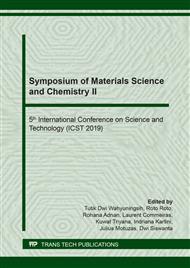[1]
A.R. Clarke, K.S. Powell, C.W. Weldon, P.W. Taylor, The ecology of bactrocera tryoni (diptera: tephritidae): what do we know to assist pest management?, Ann. Appl. Biol. 158 (2011) 26-54.
DOI: 10.1111/j.1744-7348.2010.00448.x
Google Scholar
[2]
B.C. Dominiak, J.H. Ekman, The rise and demise of control options for fruit fly in Australia, Crop Prot. 51 (2013) 57-67.
DOI: 10.1016/j.cropro.2013.04.006
Google Scholar
[3]
R.L. Metcaft, E.R. Metcaft, Chemical ecology of dacinae fruit flies (Diptera: Tephritidae), Ann. Entomol. Soc. Am. 51 (1990) 1017-1030.
DOI: 10.1093/aesa/83.6.1017
Google Scholar
[4]
T. Koeduka, B. Watanabe, S. Suzuki, J. Hiratake, J. Mano, K. Yazaki, Characterization of raspberry ketone/zingerone synthase, catalyzing the alpha, beta-hydrogenation of phenylbutenones in raspberry fruits, Biochem. Biophys. Res. Commun. 412 (2011) 104-108.
DOI: 10.1016/j.bbrc.2011.07.052
Google Scholar
[5]
I. Rajan, N. Narayanan, R. Rabindran, P.R. Jayasree, P.R.M. Kumar, Zingerone protects against stannous chloride-induced and hydrogen peroxide-induced oxidative DNA damage in vitro, Biol. Trace Elem. Res. 155 (2013) 455–459.
DOI: 10.1007/s12011-013-9801-x
Google Scholar
[6]
M.K. Kim, S.W. Chung, J.M. Kim, D.H. Kim, E.K. Lee, J.Y. Kim, Y.M. Ha, Y.H. Kim, J.K. No, H.S. Chung, K.Y. Park, S.H. Rhee, J.S. Choi, B.P. Yu, T. Yokozawa, Y.J. Kim, H.Y. Chung, Modulation of age-related NF-κB activation by dietary zingerone via MAPK pathway, Exp. Gerontol. 45 (2010) 419–426.
DOI: 10.1016/j.exger.2010.03.005
Google Scholar
[7]
R. Vinothkumar, M. Sudha, N. Nalini, Chemopreventive effect of zingerone against colon carcinogenesis induced by 1,2-dimethylhydrazine in rats, Eur. J. Cancer. Prev. 23 (2014) 361–371.
DOI: 10.1097/cej.0b013e32836473ac
Google Scholar
[8]
L.A. Stetaz, M.G.D. Liberto, M.M. Zanardi, A.G. Suarez, S.A. Zacchino, Efficient production of the (R)- and (S)-zingerols via green fungal biocatalaysis. Comparative antifungal activities between enantiomers, Int. J. Mol. Sci. 15 (2014) 22042-22058.
DOI: 10.3390/ijms151222042
Google Scholar
[9]
L. Kumar, S. Chhibber, K. Harjai, Zingerone inhibit biofilm formation and improve antibiofilm efficacy of ciprofloxacin against Pseudomonas aeruginosa PAO1, Fitoterapia 90 (2013) 73–78.
DOI: 10.1016/j.fitote.2013.06.017
Google Scholar
[10]
K.H. Tan, R. Nishida, Zingerone in the floral synomone of bulbophyllum baileyi (orchidaceae) attracts bactrocera fruit flies during pollination, Biochem. Syst. Ecol. 35 (2007) 334-341.
DOI: 10.1016/j.bse.2007.01.013
Google Scholar
[11]
Murdiah, D. Pranowo, T. J. Raharjo, Synthesis of zingerone using NiCl2.6H2O-NaBH4 as a selective hydrogenation reaction agent, Mater. Sci. Forum 948 (2018) 127-132.
DOI: 10.4028/www.scientific.net/msf.948.127
Google Scholar
[12]
L.R. Smith, Rheosmin (Rasberry ketone,) and Zingerone, and their preparation by crossed aldol-catalytic hydrogenation sequences, J. Chem. Educ. 1 (1996) 1-18.
DOI: 10.1007/s00897960034a
Google Scholar
[13]
P.F. Schatz, Bromination of acetanilide J. Chem. Educ. 73 (1996) 267-268.
Google Scholar
[14]
J.M. Khurana, A. Gogia, Synthetically useful reactions with nickel boride. A review, Org. Prep. Proced. Int. 29 (1997) 1-32.
DOI: 10.1080/00304949709355171
Google Scholar
[15]
J.M. Khurana, S. Purnima, Chemoselective reduction of α,β-unsaturated aldehydes, ketones, carboxylic acids, and esters with nickel boride in methanol-water, Bull. Chem. Soc. Jpn. 77 (2004) 549–552.
DOI: 10.1246/bcsj.77.549
Google Scholar
[16]
A. Sutanto, F. Faisal, N.L.N. Atami, Tohidin, Population fluctuations of fruit flies (bactrocera dorsalis complex.) (Diptera: tephritidae) on papaya farming in Margaluyu Village, Garut Regency, Jurnal Agrikultura 28 (2017)32-38.
DOI: 10.24198/agrikultura.v28i1.12297
Google Scholar


